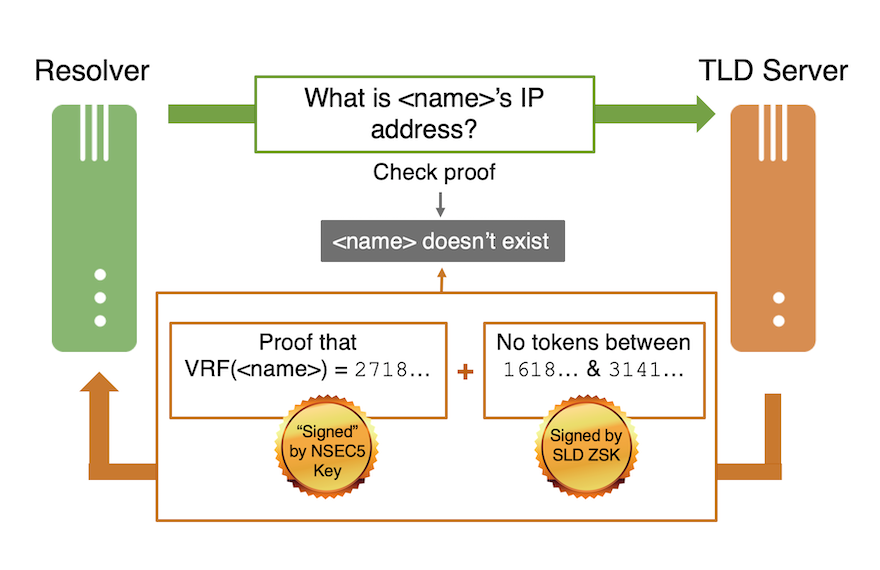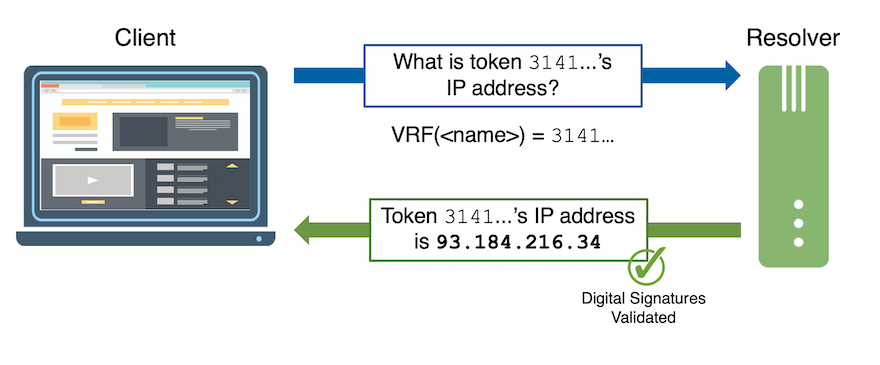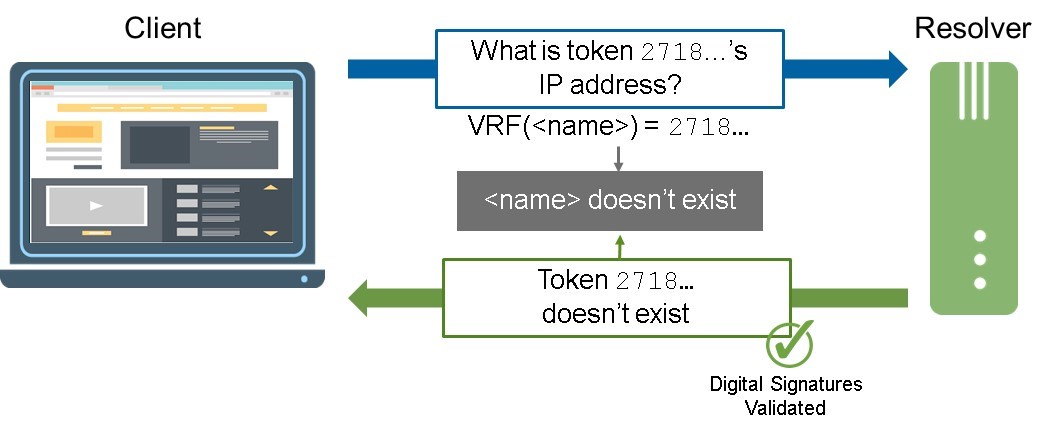This is the third in a multi-part blog series on cryptography and the Domain Name System (DNS).
In my last post, I looked at what happens when a DNS query renders a “negative” response – i.e., when a domain name doesn’t exist. I then examined two cryptographic approaches to handling negative responses: NSEC and NSEC3. In this post, I will examine a third approach, NSEC5, and a related concept that protects client information, tokenized queries.
The concepts I discuss below are topics we’ve studied in our long-term research program as we evaluate new technologies. They do not necessarily represent Verisign’s plans or position on a new product or service. Concepts developed in our research program may be subject to U.S. and international patents and patent applications.
NSEC5
NSEC5 is a result of research by cryptographers at Boston University and the Weizmann Institute. In this approach, which is still in an experimental stage, the endpoints are the outputs of a verifiable random function (VRF), a cryptographic primitive that has been gaining interest in recent years. NSEC5 is documented in an Internet Draft (currently expired) and in several research papers.
A VRF is like a hash function but with two important differences:
- In addition to a message input, a VRF has a second input, a private key. (As in public-key cryptography, there’s also a corresponding public key.) No one can compute the outputs without the private key, hence the “random.”
- A VRF has two outputs: a token and a proof. (I’ve adopted the term “token” for alignment with the research that I describe next. NSEC5 itself simply uses “hash.”) Anyone can check that the token is correct given the proof and the public key, hence the “verifiable.”
So, it’s not only hard for an adversary to reverse the VRF – which is also a property the hash function has – but it’s also hard for the adversary to compute the VRF in the forward direction, thus preventing dictionary attacks. And yet a relying party can still confirm that the VRF output for a given input is correct, because of the proof.
How does this work in practice? As in NSEC and NSEC3, range statements are prepared in advance and signed with the zone signing key (ZSK). With NSEC5, however, the range endpoints are two consecutive tokens.
When a domain name doesn’t exist, the name server applies the VRF to the domain name to obtain a token and a proof. The name sever then returns a range statement where the token falls within the range, as well as the proof, as shown in the figure below. Note that the token values are for illustration only.

Because the range statement reveals only tokenized versions of other domain names in a zone, an adversary who doesn’t know the private key doesn’t learn any new existing domain names from the response. Indeed, to find out which domain name corresponds to one of the tokenized endpoints, the adversary would need access to the VRF itself to see if a candidate domain name has a matching hash value, which would involve an online dictionary attack. This significantly reduces disclosure risk.
The name server needs a copy of the zone’s NSEC5 private key so that it can generate proofs for non-existent domain names. The ZSK itself can stay in the provisioning system. As the designers of NSEC5 have pointed out, if the NSEC5 private key does happen to be compromised, this only makes it possible to do a dictionary attack offline— not to generate signatures on new range statements, or on new positive responses.
NSEC5 is interesting from a cryptographer’s perspective because it uses a less common cryptographic technique, a VRF, to achieve a design goal that was at best partially met by previous approaches. As with other new technologies, DNS operators will need to consider whether NSEC5’s benefits are sufficient to justify its cost and complexity. Verisign doesn’t have any plans to implement NSEC5, as we consider NSEC and NSEC3 adequate for the name servers we currently operate. However, we will continue to track NSEC5 and related developments as part of our long-term research program.
Tokenized Queries
A few years before NSEC5 was published, Verisign Labs had started some research on an opposite application of tokenization to the DNS, to protect a client’s information from disclosure.
In our approach, instead of asking the resolver “What is <name>’s IP address,” the client would ask “What is token 3141…’s IP address,” where 3141… is the tokenization of <name>.
(More precisely, the client would specify both the token and the parent zone that the token relates to, e.g., the TLD of the domain name. Only the portion of the domain name below the parent would be obscured, just as in NSEC5. I’ve omitted the zone information for simplicity in this discussion.)
Suppose now that the domain name corresponding to token 3141… does exist. Then the resolver would respond with the domain name’s IP address as usual, as shown in the next figure.

In this case, the resolver would know that the domain name associated with the token does exist, because it would have a mapping between the token and the DNS record, i.e., the IP address. Thus, the resolver would effectively “know” the domain name as well for practical purposes. (We’ve developed another approach that can protect both the domain name and the DNS record from disclosure to the resolver in this case, but that’s perhaps a topic for another post.)
Now, consider a domain name that doesn’t exist and suppose that its token is 2718… .
In this case, the resolver would respond that the domain name doesn’t exist, as usual, as shown below.

But because the domain name is tokenized and no other information about the domain name is returned, the resolver would only learn the token 2718… (and the parent zone), not the actual domain name that the client is interested in.
The resolver could potentially know that the name doesn’t exist via a range statement from the parent zone, as in NSEC5.
How does the client tokenize the domain name, if it doesn’t have the private key for the VRF? The name server would offer a public interface to the tokenization function. This can be done in what cryptographers call an “oblivious” VRF protocol, where the name server doesn’t see the actual domain name during the protocol, yet the client still gets the token.
To keep the resolver itself from using this interface to do an online dictionary attack that matches candidate domain names with tokens, the name server could rate-limit access, or restrict it only to authorized requesters.
Additional details on this technology may be found in U.S. Patent 9,202,079B2, entitled “Privacy preserving data querying,” and related patents.
It’s interesting from a cryptographer’s perspective that there’s a way for a client to find out whether a DNS record exists, without necessarily revealing the domain name of interest. However, as before, the benefits of this new technology will be weighed against its operational cost and complexity and compared to other approaches. Because this technique focuses on client-to-resolver interactions, it’s already one step removed from the name servers that Verisign currently operates, so it is not as relevant to our business today in a way it might have been when we started the research. This one will stay under our long-term tracking as well.
Conclusion
The examples I’ve shared in these last two blog posts make it clear that cryptography has the potential to bring interesting new capabilities to the DNS. While the particular examples I’ve shared here do not meet the criteria for our product roadmap, researching advances in cryptography and other techniques remains important because new events can sometimes change the calculus. That point will become even more evident in my next post, where I’ll consider the kinds of cryptography that may be needed in the event that one or more of today’s algorithms is compromised, possibly through the introduction of a quantum computer.
Read the complete six blog series:
- The Domain Name System: A Cryptographer’s Perspective
- Cryptographic Tools for Non-Existence in the Domain Name System: NSEC and NSEC3
- Newer Cryptographic Advances for the Domain Name System: NSEC5 and Tokenized Queries
- Securing the DNS in a Post-Quantum World: New DNSSEC Algorithms on the Horizon
- Securing the DNS in a Post-Quantum World: Hash-Based Signatures and Synthesized Zone Signing Keys
- Information Protection for the Domain Name System: Encryption and Minimization




